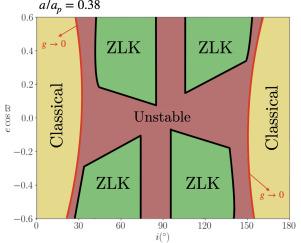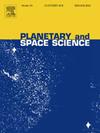Dynamical regimes of small bodies perturbed by an eccentric giant planet
IF 1.7
4区 物理与天体物理
Q3 ASTRONOMY & ASTROPHYSICS
引用次数: 0
Abstract
The dynamics of small bodies perturbed by an eccentric planet was done mostly under the assumption of well separated orbits using analytical approximations appropriate for the hierarchical case. In this work we study the dynamics of small bodies in a wide range of eccentricities and inclinations perturbed by a giant planet with , in the non-hierarchical case. We consider small bodies both interior and exterior to the planet. We apply semi-analytical models for the study of resonances and the properties of the secular disturbing function. We perform a frequency analysis of numerical integration of the exact equations of motion to obtain the proper frequencies and corresponding dynamical secular paths. We study the dependence of proper frequencies with the initial mutual inclination and we find a critical inclination around 30 degrees for which the pericenter proper frequency vanishes giving rise to the increase of small bodies eccentricities followed by unstable dynamics. This happens for both interior and exterior small bodies and constitutes a stability barrier in the inclination. For greater inclinations the ZLK mechanism dominates both populations. By means of numerical integration of thousands of small bodies we reproduce the well known pericenter shepherding, but for the exterior populations with low inclinations we also find concentrations of the longitude of the ascending node in the direction of the planetary line of apsides.

被偏心巨行星扰动的小天体的动力学机制
受偏心行星扰动的小天体的动力学主要是在轨道分离良好的假设下进行的,使用适合于分层情况的解析近似。在这项工作中,我们研究了在非分层情况下,由ep=0.4的巨行星扰动的大范围偏心和倾角的小天体的动力学。我们考虑行星内部和外部的小天体。我们应用半解析模型来研究共振和长期扰动函数的性质。我们对精确运动方程的数值积分进行频率分析,得到相应的频率和相应的动力长期路径。我们研究了固有频率与初始互倾角的关系,发现在30度左右的临界倾角下,近心固有频率消失,导致小体偏心增大,随之而来的是动力学不稳定。这种情况发生在内部和外部的小物体上,并构成了倾斜的稳定屏障。对于较大的倾斜度,ZLK机制在两个种群中都占主导地位。通过对成千上万个小天体的数值积分,我们重现了众所周知的中心周围放牧现象,但对于低倾角的外部种群,我们也发现了升交点经度在行星倾斜线方向的集中。
本文章由计算机程序翻译,如有差异,请以英文原文为准。
求助全文
约1分钟内获得全文
求助全文
来源期刊

Planetary and Space Science
地学天文-天文与天体物理
CiteScore
5.40
自引率
4.20%
发文量
126
审稿时长
15 weeks
期刊介绍:
Planetary and Space Science publishes original articles as well as short communications (letters). Ground-based and space-borne instrumentation and laboratory simulation of solar system processes are included. The following fields of planetary and solar system research are covered:
• Celestial mechanics, including dynamical evolution of the solar system, gravitational captures and resonances, relativistic effects, tracking and dynamics
• Cosmochemistry and origin, including all aspects of the formation and initial physical and chemical evolution of the solar system
• Terrestrial planets and satellites, including the physics of the interiors, geology and morphology of the surfaces, tectonics, mineralogy and dating
• Outer planets and satellites, including formation and evolution, remote sensing at all wavelengths and in situ measurements
• Planetary atmospheres, including formation and evolution, circulation and meteorology, boundary layers, remote sensing and laboratory simulation
• Planetary magnetospheres and ionospheres, including origin of magnetic fields, magnetospheric plasma and radiation belts, and their interaction with the sun, the solar wind and satellites
• Small bodies, dust and rings, including asteroids, comets and zodiacal light and their interaction with the solar radiation and the solar wind
• Exobiology, including origin of life, detection of planetary ecosystems and pre-biological phenomena in the solar system and laboratory simulations
• Extrasolar systems, including the detection and/or the detectability of exoplanets and planetary systems, their formation and evolution, the physical and chemical properties of the exoplanets
• History of planetary and space research
 求助内容:
求助内容: 应助结果提醒方式:
应助结果提醒方式:


